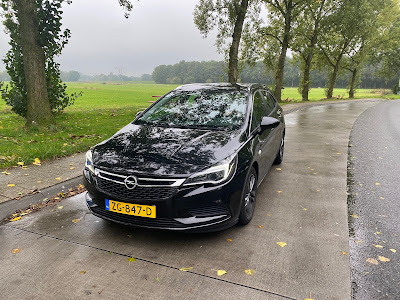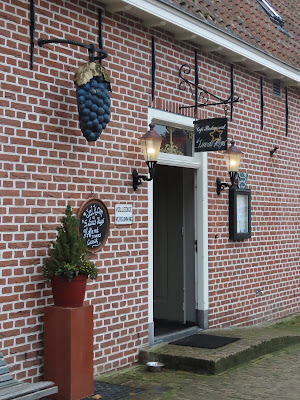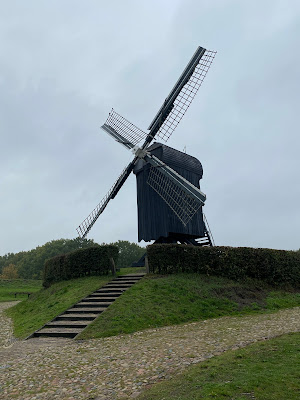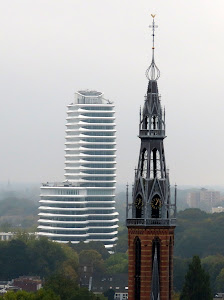Old Dutch Tour 2022
The last leg of our three part journey would start right after we disembarked from our Emerald Waterways ship and were dropped off at the Schiphol Airport in Amsterdam. Our friend Afie, who is from Holland, has arranged a great adventure to explore the areas of The Netherlands that we have never had the time to see before, some would call it an... Old Dutch Tour.

October 13
We checked some excess baggage at the airport storage, so we didn't have to carry as much luggage around with us while driving. After a short wait our rental car is dropped in front of the airport, we loaded our luggage and we hit the road.



Our first big adventure is crossing the Afsluitdijk, a major dam and causeway in the Netherlands. It was constructed between 1927 and 1932 and runs from Den Oever in North Holland province to the village of Zurich in Friesland province, over a length of 32 kilometres (20 mi) just above sea level. The Afsluitdijk is a fundamental part of the larger Zuiderzee Works, damming off the Zuiderzee, a salt water inlet of the North Sea, and turning it into a fresh water lake.


Unfortunately there was a lot of construction in the areas where you could normally stop and walk around, so we had to just look at it and the surrounding wind turbines while we drove over. Even the eel traps were interesting, if only the weather was better.




Westerlee, Netherlands
When we pull up to the Landgoed Westerlee hotel, we are all in shock. Landgoed Westerlee is located in a former Heerenboerderij, a cooperative mixed farm, owned by about 200 households.. The former barn of the farm from 1910 houses beautifully decorated hotel rooms under the characteristic beams of the old barn. Afie may have set the bar pretty high on our first hotel.








The view from our balcony






One of the great mysteries of this farmhouse room, was that on top of the AC unit above the balcony door was a single brown egg. We don't know why it was there, how it got there, and neither did any of the staff we asked about it. Was it placed there as a practical joke, did a hen climb up there and lay it? We'll never know, but I'm glad it never fell.


Off we went down the cute tree lined roads to the town of Ter Apel.



Ter Apel
Ter Apel is a village with a population of 8,866 residents in the northern Netherlands,
and home of my second cousin. It also features a farmers market once a week, and
apparently a very small car show ![]()


Today was an amazing day. Spent the afternoon with family members in the Netherlands; Marinus Krijgsveld and his 94 year old brother Jan (Broer). For those that don't know, Warfield is the translation of Krijgsveld, my Grandfather changed the name when he came over from Holland in 1926.

Marinus 78 and (broer) Jan 94
We met Marinus at his apartment in Ter Apel, and shortly after a man showed up at his door. Something important to know is that Norine and I don't speak Dutch, and Marinus doesn't speak English, but Afie speaks both, so she was our translator. When Afie was introduced to Jan Broer, she thought he was a neighbor that spoke some English. We didn't discover until much later that Jan Broer, was "my brother Jan". Apparently he comes to visit once a week on Market day, and we arrived on market day. He didn't speak English, but according to Afie, he was very funny, cracking jokes the whole time (in Dutch). We had no idea.

I learned a lot of family history that day, as soon as I arrived he pulled out a huge family tree, dating back to the time of Napoleon. Norine and I were even on there. Using Afie as our go between, we were asking all kinds of questions about our past, he was asking questions about my family, it really was quite fascinating, especially when he brought out some old photos.


When I started asking about the areas where my grandfather and his family lived, Marinus offered to take us see the places my grandfather and other family members lived and worked. We always thought it was the town of Vlagtwedde, but it turns out Vlagtwedde is a regional district and Ter Apel is the actual town where they lived. Apparently my Grandpa was born in the nearby town of Odooan.



The location where the family home was, and the area where the family had a store/market
I learned that my Great grandfather was driving boats on canals to carry potatoes, he would travel from farm to farm gathering the potatoes and take them to the city market. I also learned that one of the original Krijgsvelds went to Russia with Napoleon and came home with only one leg... could be the origin of the Warfield name.
As we are driving around Ter Apel Mrinus is giving us all kinds of history, even showing is where the Ukranian refugee centre is, before taking us to the Klooster Ter Apel is that he volunteers at.

Ter Apel Monastery (Dutch: Klooster Ter Apel) is a former monastery. It is the only monastery in the larger area of Friesland and Groningen that survived the Reformation in a decent condition, and the only remaining rural monastery from the Middle Ages in the Netherlands. Construction was between 1465 and 1561, and included, besides the convent building, a gatehouse, water mills, a parchment facility, a bakery, a brewery, and a guesthouse.











We all went for a beer and drinks at the nearby Hotel Boschhuis which was founded as a 'bakhuys' and brewhouse serving the medieval Monastery from 1465. After our drinks he dropped us back at our car and we said our goodbyes.


It was a fantastic day spending some time with Marinus, and getting to know a little of the Warfield/Krijgsveld family history.
Winschoten
On the way back to our hotel we stopped in Winschoten for dinner at Stadshuys restaurant, it's right across from the Stadshuys.


It was an excellent dinner, served with basic ingredients on your plate, and then shared bowls of the side items like potatoes and veg.



A very nice end to a very nice day.
October 14
A grey and slightly wet day in The Netherlands, but we saw some cool stuff, and had Fish & Chips overlooking the North Sea
Slochteren
The Fraeylemaborg is a borg (strong house or keep) in the village of Slochteren. The building originates from the 16th century. In 1680 the borg was sold because of family debts. The new owner extensively rebuilt the borg and he also landscaped a huge formal garden in the style of Louis XIV's France. After his death the borg fell into disrepair. In 1781 the Fraeylemaborg was sold and rebuilt into the shape it has today.




































Schildwolde is home to Juffertoren, it is one of the three damselfly towers in the province of Groningen.
“Once upon a time there were three very wealthy sisters who did nothing but party and dance. At a certain point they started to realize that such a life was very empty. They realized that they were doing no good with their wealth. Until then they had always been together, but now they decided to separate. And where each came out, there they built a tower to the glory of God. Those towers had to be exactly the same. The first came out in Holwierde and built a tower there, the second came out in Schildwolde and built her tower there and the third built her tower in Onstwedde. There are three towers that can be seen from afar and are a feast for the eyes.”



The mill Aeolus (Farmsum windmill) was built in 1811 (or possibly a little before) as a corn and hulling mill. At this point of the trip, we were very excited to see windmills, and pulled over whenever we could safely see one.


Delfzijl
From the latest windmill we drove as far North as we could go to Delfzijl, to have Fish & Chips at Eemshotel overlooking the North Sea.









Bourtange
We see some crazy things on our way back South to the town of Bourtange; A road that opens directly in front of us, and some of the happiest hay-bales we have ever seen. Even stranger when we arrive, is this crazy machine that cleans out canals.


Our next stop was the star shaped Bourtange Fortress Museum (Stichting Vesting Bourtange). It was built under orders of William the Silent and completed in 1593. Its original purpose was to control the only road between Germany and the city of Groningen, which was controlled by the Spaniards during the time of the Eighty Years' War. After experiencing its final battle in 1672, the fort continued to serve in the defensive network on the German border until it was finally given up in 1851 and converted into a village.















It really was a cute village, and although certain buildings are accessible as a museum, most of the buildings are peoples homes.






























Guard post and toilet


Winschoten
After the star fort, we headed back to Winschoten to do a little "shopping", pretty funny to find a Canadian Tire ornament in a Christmas store. Mostly we got some baked goods for a visit to some of Afie's long time friends.




Another stop for another windmill. the Dijkstra windmill in Winschoten. This is the largest of the three impressive Winschoten windmills and was used as a grain and peel mill, it was built in 1862.



We spent the evening in a traditional Dutch home... Afie's friends Leo and Dieneke, and their son Jan-Jaap. We had a lovely evening with a lot of laughs and a wide assortment of traditional Dutch appetizers, and Norine found a new favourite drink, Rivella. What is Rivella? Rivella is a soft drink from Switzerland, created in 1952, which is produced from milk whey, and therefore includes ingredients such as lactose, lactic acid and minerals. Not for all taste buds but quintessentially Swiss...and apparently Dutch.
October 15
Groningen
Today we took the train to Groningen and wandered the shopping streets and looked at the outside of churches. (They were closed due to lack of volunteers). Groningen is the economic and cultural centre of the northern part of the country.




























Each of the 3 items above were purchased




The local mode of transportation (delivery vehicles)
The Aa-kerk is a historic former parish church named after the nearby river Aa. The chapel was transformed into a brick gothic church between 1425 and 1495. Today it is used as a venue for concerts, theatre, exhibitions, parties and meetings. Church services are no longer held




As we are getting closer to Halloween, we are seeing all kinds of people dressed up and wandering the streets, funny thing is that most of them were teens and adults.


The Martinitoren (Martini or St. Martin's Tower) is the tallest church steeple in the city of Groningen, and the bell tower of the Martinikerk. The third and current tower was largely built between 1469 and 1482 from blocks of sandstone, the previous 2 towers were destroyed by lightning. It contains a brick spiral staircase consisting of 260 steps, and the carillon within the tower contains 62 bells. Unfortunately because of staff shortages we couldn't go into the tower.



The Forum is a new building with an upper deck, the inside contains a library and other educational areas. The best part is that it allows free access to the rooftop for great viewpoints over several churches, the Martinitoren and the rest of the city.




Martinikerk, a landmark church dating back to 800 AD  Grafisch Museum Groningen (History of Graphic
Design)
Grafisch Museum Groningen (History of Graphic
Design)






One of the inside areas of The Forum is currently exhibiting an Art of DC comics display.



We had a nice lunch at De Drie Gezuster with a few of their local beers.


Seeing this mobile Music box was a great treat after having seen the museum in Rudesheim on the cruise portion of our trip.




Back at the Groningen Train Station, which was voted as one of the nicest stations in
the Netherlands.
I can verify that it is the nicest Starbucks I have ever been in.







Tonight we had dinner at our Westerlee hotel, it was very Fancy Schmancy, and also very good. We did get a few looks from a couple at another table, apparently our travel wear isn't up to their standards, so I gave them a wink, and they stopped looking at us.


In the morning we packed up, said goodbye to our egg, and drove to the town of Apeldoorn.


